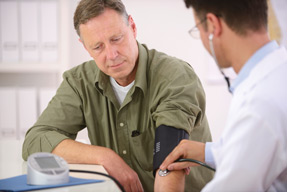Maintaining men's health in middle age
Adrenopause, somatopause, andropause... manopause? They all give internists pause when considering men's health as they reach middle age. As men try to maintain optimum health, doctors need to define what exactly that is.
It seems only recently that certain quality-of-life issues related to men's aging, such as low testosterone, erectile dysfunction or benign prostatic hyperplasia, have begun to share center stage with chronic conditions such as heart disease, diabetes and cancer.
One of the clearest illustrations of this phenomenon might be the increase in sales of androgen replacement therapy used to treat low testosterone. According to a research letter published in JAMA Internal Medicine in 2013, androgen use among men age 40 years or older tripled between 2001 and 2011. Of interest, data also showed that 25% of all new androgen users in the study had not had their testosterone levels measured in the 12 months before initiation.

“When I was training in the 1980s, testosterone sales totaled about $18 million,” said Shalender Bhasin, MD, FACP, professor of medicine at Boston University School of Medicine. “This past year testosterone sales are projected to have approached around $2.2 billion, and that is a conservative estimate.”
According to Dr. Bhasin, this is just one indicator of the tremendous interest in issues related to men's health in middle age. Faced with the growing emphasis on patient-centered care and a patient population more frequently exposed to direct-to-consumer advertising, internists must be able to appropriately diagnose these conditions, identify legitimate need for treatment, and balance related safety concerns, experts said.
‘Manopause’
The term “manopause” is sometimes used in the lay media to describe some of the hormonal changes men experience as they enter middle age. However, many in the health community are hesitant to compare the 2 conditions. When Glenn D. Braunstein, MD, MACP, professor of medicine at Cedars-Sinai, Los Angeles, discusses “manopause,” he describes it using 3 criteria: adrenopause, somatopause and andropause.
Adrenopause describes the decline in production of dehydroepiandrosterone (DHEA), the adrenal androgen precursor. However, Dr. Braunstein said that adrenopause is a somewhat fallacious concept, with no good evidence that giving DHEA back to aging individuals has any positive benefit.
Similarly, somatopause is the natural decrease in growth hormone levels that occurs with age. True growth hormone deficiency in adults is fairly uncommon, Dr. Braunstein said, unless there is an underlying pituitary condition.
“Just because the levels go down compared with individuals in their 20s does not mean that older individuals have a disease state or that giving growth hormone is going to reverse the aging process,” Dr. Braunstein said. “The concepts of adrenopause or somatopause as part of ‘manopause’ are sort of biochemical concepts that have not been tied to any physical or pathophysiologic reality.”
However, andropause is a different story, he said. Testosterone typically declines with age. When declining testosterone is combined with signs and symptoms of hypogonadism, men may have a legitimate health concern.
Diagnosing hypogonadism
Estimates of the prevalence of hypogonadism vary widely across studies. Data from the Hypogonadism in Males (HIM) study estimated that about 39% of men age 45 years or older had hypogonadism. In contrast, data from the Massachusetts Male Aging Study (MMAS) found that between 6% and 12% of studied men had hypogonadism, and data from the European Male Aging Study (EMAS) put the estimate at closer to 2% to 3%.
Part of the discrepancy in the data may be due to varying definitions of hypogonadism. The MMAS defined hypogonadism through a combination of signs and symptoms plus total and calculated free testosterone. The EMAS used a stricter definition of the presence of 3 sexual symptoms combined with total testosterone levels below 11 nmol/L (317 ng/dL) and free testosterone levels below 220 pmol/L (70 pg/mL). The HIM study defined hypogonadism as a total testosterone level below 300 ng/dL (10.4 nmol/L), which Dr. Braunstein said is not sufficient to recommend therapy.
The Endocrine Society only recommends making a diagnosis of hypogonadism in men with both consistent signs and symptoms and with “unequivocally low serum testosterone levels.” Physical symptoms of hypogonadism include erectile dysfunction, infertility, a decrease in muscle mass, loss of bone mass and the development of breast tissue. In addition, the associated decline in testosterone may lead to mental changes such as fatigue, a decreased libido or difficulty concentrating.
Many of the issues related to diagnosing cases of hypogonadism relate to measuring testosterone.
“‘Normal’ testosterone is a very wide range and it certainly changes with age, making it unclear when a man is below the threshold,” said Stuart Seidman, MD, assistant professor in the department of psychiatry at Columbia University College of Physicians and Surgeons in New York. “Even more interesting, in the MMAS they showed that in men above age 45 who were tested longitudinally, more than half of men who were found to have low testosterone were back to normal levels when tested years later.”
Ideally, testosterone should be tested in the morning due to diurnal variations. Testing done on multiphasic platforms, such as blood chemistry panels used to test blood count and other metrics with a single sample, can lack accuracy. Instead, gas chromatography tandem mass spectroscopy has become the gold standard.
The Endocrine Society defines a normal range for testosterone in men from 300 ng/dL to 1,000 ng/dL. However, Dr. Braunstein emphasized that “normal” may be different for each man, and that a normal level for men in their 60s is likely to be lower than the “normal” level in men in their 20s.
“In addition, because men experience microsecretory spurts of testosterone throughout the day, I draw 3 blood samples at 20-minute intervals between 8 and 10 a.m., and combine equal amounts of the serum in a single tube, and measure the testosterone in that,” Dr. Braunstein said.
Internists can also look to the CDC for recommendations on laboratories certified for testosterone procedures, Dr. Bhasin said. In 2008, the CDC met with experts from several major medical societies to discuss concerns related to testing testosterone and other hormones. It has since launched the Hormone Standardization Program to standardize testosterone testing and increase its reliability.
According to its website, the program is nonregulatory, and it helps clinical, research, and public health laboratories maintain and enhance the quality and comparability of measurement results obtained from hormone tests. Labs that have successfully met the CDC's performance criteria can be found online.
If lab testing indicates that testosterone is low, internists should also measure luteinizing hormone and follicle-stimulating hormone. Raised luteinizing hormone and follicle-stimulating hormone levels indicate that the low testosterone may have a primary testicular cause. If levels are low, the cause may be hypothalamic or pituitary. If a pituitary cause is suspected, a prolactin should be measured to rule out hyperprolactinemia, and, if the testosterone is below 150 ng/dL, an MRI should be considered to evaluate the patient for a space-occupying lesion, Dr. Braunstein said.
When considering testosterone therapy, clinicians must also consider recent studies that have linked testosterone use to an increased risk for heart disease. Specifically, a study published recently in PLoS One showed that older men had double the risk for myocardial infarction after the initiation of testosterone therapy.
“There were three articles recently that made an association between increased risk of heart disease in older individuals with testosterone therapy, but several of these were epidemiological studies, which does not prove cause and effect,” Dr. Braunstein said. “There is currently a prospective trial looking at this topic.”
Until those results are available, he said he would delay starting testosterone in a patient with significant coronary artery disease unless the patient had severe symptoms of androgen deficiency.
If treatment is determined as necessary and safe after testing, Dr. Braunstein will recommend a therapeutic trial of testosterone. The easiest options are transdermal testosterone; however, if those are not effective he would also consider prescribing injectable testosterone. The key with either treatment is to prescribe only in the presence of low testosterone and symptoms and to look for improvement of symptoms as the patient begins treatment.
Erectile dysfunction
“One confusion that physicians and certainly patients have is that they equate sexual dysfunction with testosterone deficiency, which is not the case,” Dr. Bhasin said. “Erectile dysfunction and hypogonadism are two different entities.”
Three phosphodiesterase type 5 inhibitors are currently FDA-approved for the treatment of erectile dysfunction, and direct-to-consumer advertising has significantly increased the exposure of these medications among the public. A 2006 study published in Family Medicine looked at data from 2 national surveys and found that half of men age 30 years or older who received a prescription for sildenafil had no documented presenting symptom or diagnosis consistent with erectile dysfunction.
“Physicians used to go through an extensive workup with patients with erectile dysfunction to find an underlying cause,” Dr. Braunstein said. “Now, what is frequently done is if a patient complains of erectile dysfunction they get [an erectile dysfunction drug] and go on a therapeutic trial of it.”
Erectile dysfunction can often be multifactorial. Before prescribing medication, both Drs. Bhasin and Braunstein recommended taking a thorough history and conducting a physical examination to determine what the underlying problem might be.
“One should also determine if the patients is really saying they have erectile dysfunction—the inability to get and maintain an erection adequate for penetration—or is the individual saying that the quality of the erection is not the same as it was when they were 20,” Dr. Braunstein said. “In these cases, it may be part of the normal aging process.”
Dr. Braunstein recommended trying to obtain a thorough history by asking patients questions such as:
- Do you experience erectile dysfunction with all partners or just one?
- Can you achieve an erection through self-stimulation?
- Can you clarify if you are experiencing erectile dysfunction or suffering from a loss of libido?
In addition, he said, the patient should be screened for medications that may cause erectile dysfunction, such as diuretics, antidepressants or antianxiety drugs, antihistamines, nonsteroidal anti-inflammatory drugs, antiarrhythmics and muscle relaxants.
Erectile dysfunction can also be an early manifestation of atherosclerosis, Dr. Bhasin added, so patients with a new diagnosis should be screened for diabetes or heart disease. The condition can also be linked to hypogonadism or an enlarged prostate.
Benign prostatic hyperplasia
As they age, many men will have an enlarged prostate or benign prostatic hyperplasia, said James Stulman, MD, FACP, assistant professor of medicine at Weill Cornell Medical College in New York. The most commonly reported problems associated with an enlarged prostate are increased urinary frequency and nocturia, he noted.
“This can start in the 40s, but usually a large percentage of men over 50 will have some urinary symptoms, including urgency and frequency,” Dr. Stulman said.
During diagnosis of prostate issues, a patient's quality of life often comes into play, he said, and since these symptoms progress slowly with age, the amount of disturbance to a man's life may be the best indication for treatment.
Although prescription treatments are available, Dr. Stulman said that he often counsels behavioral changes first. Normal counseling could include advising patients to limit drinking before bedtime, remember to empty the bladder before bed or long car trips, or reduce or eliminate certain alcoholic beverages.
In cases where alterations to behavior do not suffice, the mainstay of treatment is alpha-blockers, such as tamsulosin, which relax the smooth muscle tissue found in the prostate and bladder neck. Use of these medications should help to relieve symptoms, but they can also be associated with some side effects, such as abnormal ejaculation or dizziness.
Middle-aged men may also approach their internists about the possibility of prostate-specific antigen (PSA) testing to screen for prostate cancer. The most recent guidelines from the American Urological Association recommend against regular PSA screening in men age 40 to 54 years, and the U.S. Preventive Services Task Force recommends against PSA screening regardless of age.
In conversations with patients, Dr. Stulman said that he reiterates that PSA screening is highly controversial and discusses the risks and benefits with the patients.
“Discussion topics include the lack of accuracy of the test and that if the test were to come back elevated, the high likelihood that a urologist would do a prostate biopsy,” Dr. Stulman said. “I also mention that even if the biopsy shows intermediate-grade cancer, it may not be in the best interest of the patient to do anything about it.”
He emphasizes to the patient that it is a complicated issue and is never urgent enough to make a decision in-office if the patient needs more time to think about it. However, if a patient is firm about wanting PSA screening, Dr. Stulman said that he rarely refuses the test.
“I just want to make sure that they know it's a slippery slope,” he said.
Normal aging process
Dr. Bhasin underscored that the treatment of any conditions affecting middle-aged men should be done within the context of encouraging a healthy lifestyle, including both physical and mental health.
“There will never be a time where a patient comes in with a symptom, we give them a pill, and they will be cured,” Dr. Bhasin said.
As men move into middle age, it is important to counsel them to eat a healthy diet, get enough sleep, maintain physical activity, reduce alcohol intake, and quit smoking, physicians agreed.
And there are certain aspects of aging that men must accept, the physicians again agreed. Normal aging often means an increased fat mass, decreased muscle mass, issues with frailty, cognitive decline, and decreases in hormonal levels. The acute onset of any of these symptoms, however, is a red flag and should be investigated further.
Diagnosing and treating conditions like hypogonadism, erectile dysfunction, or benign prostatic hyperplasia are important and help to improve the quality of life of men as they age, but Dr. Braunstein pointed out that even Ponce de León never found the Fountain of Youth.
“There are a lot of things that change as we age, and the fact of the matter is, we all end up dying,” he said. “Nobody lives forever.”




